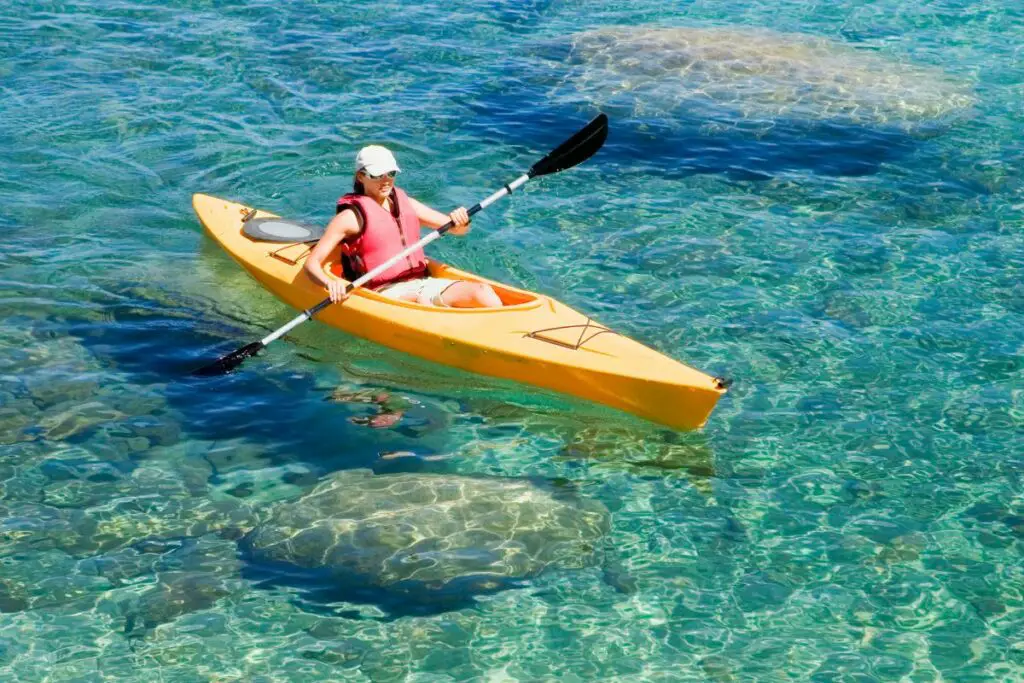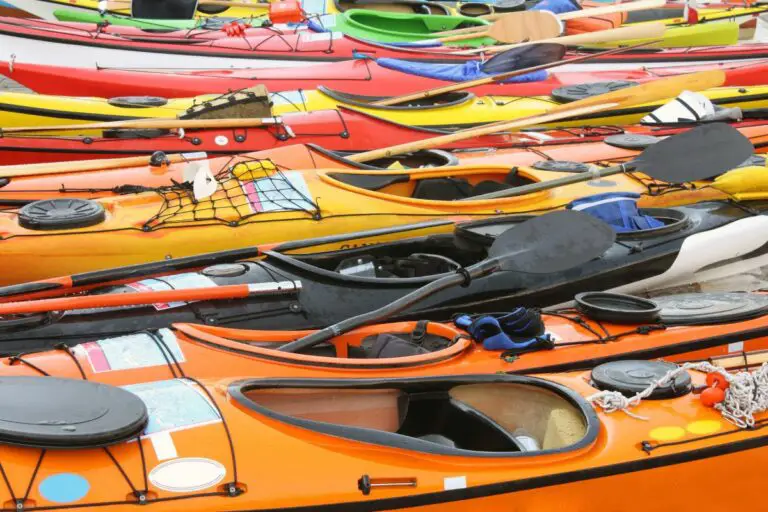The 7 Dangers of Kayaking in the Ocean and How to Avoid Them
If you live near the ocean, it’s very tempting to go Kayaking there, but kayaking in oceans and kayaking in rivers are two very different experiences.
Rivers and lakes are calm and contained, but the ocean is neither. The ocean is vast, deep, and endless, and kayaking in it offers its own set of unique challenges, but does this make it unsafe?
In other words; can you actually kayak safely in the ocean? And what are the dangers of ocean kayaking?
The dangers of kayaking in the ocean include strong currents, waves, cold water, sudden weather changes, and marine life. To kayak safely, you need to use proper gear, plan ahead, check weather forecasts, and paddle with a partner. Also, avoid going beyond your abilities or taking unnecessary risks.
Keep reading to learn more about how kayaking is different from river kayaking and how to avoid the dangers of ocean kayaking.
Table of Contents
Can You Kayak in the Ocean?

You can kayak in the ocean. However, it is more challenging and potentially dangerous than kayaking in calmer waters such as lakes and slow-moving rivers.
Kayaking in the ocean requires some training to learn proper paddling techniques and improve your skill. It also requires using proper equipment and taking safety precautions to minimize risks and ensure a safe and enjoyable experience.
Is Ocean Kayaking Different from River Kayaking?
While it may seem like all kayaking is the same, there are actually two main types: river kayaking and ocean kayaking. Both activities involve paddling a small boat through the water, but they can differ in several ways.
Of course, one of the most notable differences is the environment in which they are practiced.
Ocean kayaking is done in the open sea, often in more challenging conditions, such as waves, tides, currents, and potential exposure to weather changes. In contrast, river kayaking involves navigating rapids, rocks, and other obstacles in fast-moving water.
The gear used in each type of kayaking can also vary.
For instance, ocean kayakers typically use longer and narrower kayaks that are designed to handle rougher conditions, while river kayakers use shorter and wider boats that are more maneuverable in tight spaces.
Ocean kayakers also use specialized safety gear such as wetsuits, life jackets, and spray skirts.
Overall, ocean kayaking and river kayaking require different skill sets, gear, and safety precautions. You need to receive proper training and be familiar with the risks and challenges of each type of kayaking before attempting either activity.
What Kind of Kayak Is Best for the Ocean?
When it comes to ocean kayaking, the best type of kayak is one that is specifically designed for use in the open sea.
So, here are some key features to look for in an ocean kayak:
- Length: An ocean kayak should be long enough to handle waves and currents, typically between 14 and 18 feet.
- Width: Ocean kayaks should be narrow enough to allow for easy maneuvering through waves, typically between 22 and 25 inches wide.
- Hull shape: An ocean kayak should have a V-shaped hull to cut through waves and stabilize in rough conditions.
- Weight: Ocean kayaks should be lightweight and easy to maneuver, as they may need to be transported over long distances.
- Deck: An ocean kayak should have a low deck with a spray skirt to keep water out and prevent swamping in rough conditions.
- Safety features: Look for an ocean kayak with built-in features such as flotation devices, deck lines, and a self-rescue system.
Basically, an ocean kayak should be designed to handle the challenges of the open sea, including waves, tides, and currents.
If you’re still not sure what kayak to get, I recommend the Perception Carolina 14, with its high-performance hull design, durable construction, comfortable seating, and ample storage space. It allows for high stability, efficient tracking, and smooth maneuvering, making it an excellent choice for those starting out with ocean kayaking.

For more recommendations, check my guide on the best ocean kayaks here where I tested and reviewed the most popular ocean kayaks at every price point and recommend the best kayak for you based on your need and budget.
Is Kayaking in the Ocean Dangerous?

Kayaking in the ocean can be dangerous, particularly for those who are inexperienced or unprepared, as the ocean presents several hazards that are not present in calmer waters.
However, with proper training, equipment, and safety precautions, the risks of ocean kayaking can be minimized.
The Dangers of Kayaking in the Ocean
Here are some of the main dangers of ocean kayaking:
- Strong currents: Ocean currents can be very strong and unpredictable, making maintaining control of the kayak difficult. In extreme cases, currents can sweep kayakers out to sea or into dangerous areas such as shipping lanes or rocky shorelines.
- High waves: Ocean waves can be much larger and more powerful than waves on lakes or rivers, which can be challenging to navigate in a kayak. Large waves can capsize a kayak or cause it to spin out of control, putting the kayaker at risk of injury or drowning.
- Sudden weather changes: The weather in the open sea can change quickly, and sudden storms or gusty winds can catch kayakers off guard. Strong winds can make it difficult to paddle, and storms can produce large waves that can be hazardous for kayakers.
- Cold water: Even in warm climates, ocean water can be cold, and kayakers can be at risk of hypothermia if they are not wearing appropriate gear. Cold water can also reduce dexterity, making it more difficult to control the kayak.
- Marine life: The ocean is home to a variety of marine life, some of which can be dangerous to kayakers. Sharks, jellyfish, and other creatures can pose a risk to kayakers, particularly if they are in close proximity to the kayak.
- Getting lost at sea: Ocean conditions can change rapidly, and strong currents and winds can quickly push kayakers off course, so it’s very easy to get lost in open water, especially for those who are unfamiliar with the area.
- Other vessels: Boat traffic is a significant concern for kayakers, especially in busy harbors and coastal areas. Large vessels such as cargo ships and cruise liners can create powerful waves that can even the most experienced kayaker capsize.
How to Stay Safe While Ocean Kayaking?
It is important to follow certain safety measures and precautions to stay safe while ocean kayaking. Here are some tips for staying safe while ocean kayaking:
- Take a kayaking course: Before heading out on the ocean, it is important to have proper training in different kayaking techniques and ocean safety. Taking a course can help you learn the necessary skills and knowledge to handle the challenges of ocean kayaking.
- Check weather and water conditions: Before heading out, check the weather forecast and water conditions to make sure they are suitable for kayaking. Avoid kayaking in rough conditions or high winds, as they can make it difficult to control the kayak.
- Wear appropriate safety gear: Always wear a properly fitting personal flotation device (PFD), as well as a wetsuit or drysuit, depending on the water temperature. Additionally, consider wearing a helmet and other protective gear for additional safety.
- Paddle with a partner: Paddling with a partner can provide additional support and safety in case of an emergency. Stay within sight and earshot of your partner at all times.
- Carry essential equipment: Carry a marine radio, a whistle, flares, and a personal locator beacon (PLB) in case of an emergency. Also, navigational tools such as a compass or GPS, as well as extra water and food, sunscreen, and a first-aid kit.
- Be aware of marine life: Be aware of the types of marine life that are common in the area where you are kayaking. Avoid disturbing marine life, and be cautious of creatures that may pose a danger, such as sharks or jellyfish.
By following these tips, you can minimize the risks of ocean kayaking and enjoy a safe and enjoyable experience on the water. Always prioritize safety and be prepared for the challenges that may arise while kayaking in the ocean.
What to Do If Your Kayak Capsizes in the Ocean?
Capsizing in the ocean is a possibility when kayaking, and it can put your life at significant risk. So, here are the steps to follow if your kayak capsizes in the ocean:
- Stay calm and try to keep your head above water.
- Hold on to your kayak, as it will help you float and give you something to hold on to.
- Assess the situation and determine if you can get back into the kayak or if you need to swim to shore. If the water is too cold or you are too far from shore, it may be best to stay with the kayak.
- If the kayak is stable, try to get back in by flipping it over, swimming to the back, and pulling yourself up onto the kayak.
- If you cannot get back into the kayak, swim to shore. If you are wearing a PFD, you should be able to float and swim to shore.
- If you cannot swim to shore or get back into the kayak, use your whistle, radio, or other signaling device to call for help.
Check out the following video to learn how to get back into your kayak after capsizing quickly and easily:
Kayak your way to Freedom
- On a budget? Check out the best fishing kayaks under $500 here and the best Fishing Kayaks under $1,000 here. Or Check the best Cheap Kayaks here.
- Going fishing? Here are the best Ocean fishing kayaks, and here are the best River Fishing Kayaks.
- You can also find the best Fly Fishing Kayaks here and the best Bass Fishing Boats here.
- A bit experienced? Check out the best modular kayaks here and the best tandem fishing kayaks here.
- Looking for something special? Check out my favorite Ducky kayaks here.
- Navigate your way with these awesome and beginner-friendly Kayak compasses.
- Going Hunting? These Duck hunting kayaks will give you an unfair advantage!
- Have a need for speed? These motorized kayaks will get you moving.
- Protect yourself from the sun with these Kayak shades, and make your kayak more comfortable with these Kayak seats.
- Keep your feet dry and warm with these superb Kayaking shoes.
- Going Kayaking in cold water? Stay warm with these Kayaking gloves.
- Paddle Less, Fish More with the Best Kayak Motors
- Looking to get a trolling motor on your kayak? Check out the best kayak trolling motor mounts here.
If you like this article, please share it or pin it, you can find the share buttons below. We will really appreciate it ❤️








